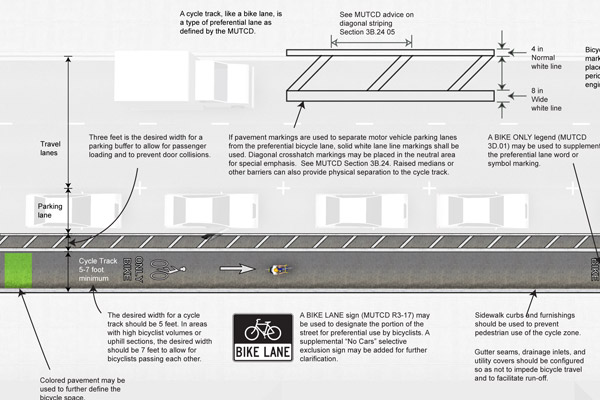
NACTO, the National Association of City Transportation Officials, recently brought its "Cities for Cycling" roadshow to Chicago; it's an initiative to spread good ideas about building bike infrastructure into cities around the country. Streetsfilms did a nice video wrap-up, in which you can see the new Kinzie bike lane and compare it to approaches in other cities:
NACTO's "Cities for Cycling" Roadshow Rocks Chicago from Streetfilms on Vimeo.
I got to take the Kinzie bike lane for the first time a few weeks ago, and though it's not terribly useful to me given where I usually bike to and from, it was a nice respite from my usual routes. For me the biggest barrier to biking, aside from giving up the chance to read on the bus, is the cars. It's actually not the winter part:
I started as an intern here last month, and arriving most recently from California, I was thrown by the sight of a bundled-up biker pedaling his way down Dearborn two weeks ago during a snowstorm. One of my fellow bus-stop loiterers gave a “Woo!” of excitement and encouragement and the biker cheered back. I thought, "You have to be crazy to bike through slush, ice, and snowfall in the midst of Chicago city traffic." Less than ten minutes later a second bicyclist rolled by.
If we're talking how well you stay warm over a commute, biking in cold weather is actually a bit better than waiting 20 minutes for a bus, since it generates a lot of heat. The problem isn't so much the cold as it is being sweat-and-slush-soaked when you arrive at work.
I've never been in an accident, and only had one particularly scary close call, but being in traffic gets wearying—low-level but ongoing stress I can't fully shake. And without a dedicated bike lane, you're in traffic. Given that the Kinzie lane is just separated by plastic posts, it might seem like a small distinction, but half of traffic management is perception. When I'm on the street, I perceive drivers as a threat, and occasionally they perceive me as a threat as well. And we're both a bit right. The better defined a bike lane is, even if it wouldn't really protect you from a speeding car, the better it defines expectations for bikers and drivers.
As pointed out in the video, the Kinzie lane (in NACTO terminology, a "protected track") was inspired by NACTO's guidelines for good bike-traffic management. Which I'm hopeful about; bikes in Chicago always stir up a hornet's nest, and the best way to confront it might be the reassurance of better-defined lanes.
Update: More on NACTO from the always-excellent Grid Chicago.
Image: NACTO


